该整合项目完全参照 狂神说java 的《springboot整合shiro框架》教学视频完成,如有不懂的地方可以查看该教学视频。
目录:

1.该整合项目所需的依赖
<dependencies> <!-- subject 用户 securityManager 管理所有用户 realm 连接数据 --> <!--连接数据库的依赖--> <dependency> <groupId>mysql</groupId> <artifactId>mysql-connector-java</artifactId> <version>8.0.15</version> </dependency> <dependency> <groupId>log4j</groupId> <artifactId>log4j</artifactId> <version>1.2.17</version> </dependency> <dependency> <groupId>com.alibaba</groupId> <artifactId>druid</artifactId> <version>1.1.13</version> </dependency> <!--引入mybatis,这是mybatis官方提供的适配springboot的,而不是springboot自己的--> <dependency> <groupId>org.mybatis.spring.boot</groupId> <artifactId>mybatis-spring-boot-starter</artifactId> <version>2.1.2</version> </dependency> <!--不想书写setter、getter方法,导入此依赖--> <dependency> <groupId>org.projectlombok</groupId> <artifactId>lombok</artifactId> <version>1.16.22</version> </dependency> <!--shiro整合spring的包--> <dependency> <groupId>org.apache.shiro</groupId> <artifactId>shiro-spring</artifactId> <version>1.4.2</version> </dependency> <dependency> <groupId>org.springframework.boot</groupId> <artifactId>spring-boot-starter-web</artifactId> </dependency> <dependency> <groupId>org.springframework.boot</groupId> <artifactId>spring-boot-starter-test</artifactId> <scope>test</scope> <exclusions> <exclusion> <groupId>org.junit.vintage</groupId> <artifactId>junit-vintage-engine</artifactId> </exclusion> </exclusions> </dependency> <!--导入thymeleaf依赖--> <dependency> <groupId>org.thymeleaf</groupId> <artifactId>thymeleaf-spring5</artifactId> <version>3.0.11.RELEASE</version> </dependency> <dependency> <groupId>org.thymeleaf.extras</groupId> <artifactId>thymeleaf-extras-java8time</artifactId> <version>3.0.4.RELEASE</version> </dependency> <!--shiro-thymeleaf整合--> <dependency> <groupId>com.github.theborakompanioni</groupId> <artifactId>thymeleaf-extras-shiro</artifactId> <version>2.0.0</version> </dependency> </dependencies> <repositories> <repository> <id>aliyun-repos</id> <url>http://maven.aliyun.com/nexus/content/groups/public/</url> <snapshots> <enabled>false</enabled> </snapshots> </repository> </repositories> <pluginRepositories> <pluginRepository> <id>aliyun-plugin</id> <url>http://maven.aliyun.com/nexus/content/groups/public/</url> <snapshots> <enabled>false</enabled> </snapshots> </pluginRepository> </pluginRepositories> <build> <plugins> <plugin> <groupId>org.springframework.boot</groupId> <artifactId>spring-boot-maven-plugin</artifactId> </plugin> </plugins> </build> </project>
2. application.yml设置连接数据库的相关配置
spring: datasource: username: root password: 123456 #?serverTimezone=UTC解决时区的报错 url: jdbc:mysql://localhost:3306/mybatis?serverTimezone=UTC&useUnicode=true&characterEncoding=utf-8 driver-class-name: com.mysql.cj.jdbc.Driver type: com.alibaba.druid.pool.DruidDataSource #Spring Boot 默认是不注入这些属性值的,需要自己绑定 #druid 数据源专有配置 initialSize: 5 minIdle: 5 maxActive: 20 maxWait: 60000 timeBetweenEvictionRunsMillis: 60000 minEvictableIdleTimeMillis: 300000 validationQuery: SELECT 1 FROM DUAL testWhileIdle: true testOnBorrow: false testOnReturn: false poolPreparedStatements: true #配置监控统计拦截的filters,stat:监控统计、log4j:日志记录、wall:防御sql注入 #如果允许时报错 java.lang.ClassNotFoundException: org.apache.log4j.Priority #则导入 log4j 依赖即可,Maven 地址:https://mvnrepository.com/artifact/log4j/log4j filters: stat,wall,log4j maxPoolPreparedStatementPerConnectionSize: 20 useGlobalDataSourceStat: true connectionProperties: druid.stat.mergeSql=true;druid.stat.slowSqlMillis=500
3.index.html
<!DOCTYPE html> <html lang="en" xmlns:th="http://www.w3.org/1999/xhtml?" xmlns:shiro="http://www.thymeleaf.org/thymeleaf-extras-shiro" > <head> <meta charset="UTF-8"> <title>Title</title> </head> <body> <h1>首页</h1> <div th:if="${session.loginUser==null}"> <a th:href="@{/toLogin}">登录</a> </div> <p th:text="${msg}"></p> <hr> <div shiro:hasPermission="user:add"> <a th:href="@{/user/add}">add</a> </div> <div shiro:hasPermission="user:update"> <a th:href="@{/user/update}">update</a> </div> <a th:href="@{/logout}">注销</a> </body> </html>
4.add.html和update.html
<!DOCTYPE html> <html lang="en"> <head> <meta charset="UTF-8"> <title>Title</title> </head> <body> <h1>add</h1> </body> </html> ------------------------------------------------- <!DOCTYPE html> <html lang="en"> <head> <meta charset="UTF-8"> <title>Title</title> </head> <body> <h1>update</h1> </body> </html>
5.login.html
<!DOCTYPE html> <html lang="en" xmlns:th="http://www.w3.org/1999/xhtml?"> <head> <meta charset="UTF-8"> <title>Title</title> </head> <body> <h1>登录</h1> <hr> <p th:text="${msg}" style="color:red;"></p> <form th:action="@{/login}"> 用户名:<input type="text" name="username"><br> 密码:<input type="password" name="password"> <br> <input type="submit" name="提交"> </form> </body> </html>
6.MyController.java
@Controller public class MyController { @RequestMapping({"/","/index"}) public String toIndex(Model model){ model.addAttribute("msg","hello,shiro!"); return "index"; } @RequestMapping("/user/add") public String add(){ return "user/add"; } @RequestMapping("/user/update") public String update(){ return "user/update"; } @RequestMapping("/toLogin") public String toLogin(){ return "login"; } @RequestMapping("/login") public String login(String username,String password,Model model){ //获取当前用户 Subject subject = SecurityUtils.getSubject(); //封装用户的登录数据 UsernamePasswordToken token = new UsernamePasswordToken(username, password); try{ subject.login(token); //执行登录的方法,如果没有异常就说明ok了 return "index"; }catch (UnknownAccountException e){ //用户名不存在 model.addAttribute("msg","用户名不存在!"); return "login"; }catch (IncorrectCredentialsException e){ model.addAttribute("msg","密码错误!"); return "login"; } } @RequestMapping("/noauth") @ResponseBody public String unauthorized(){ return "未授权无法访问此页面"; } @RequestMapping("/logout") public String logout(){ //获取当前用户 Subject subject = SecurityUtils.getSubject(); System.out.println(subject.getSession().getAttribute("loginUser")); subject.logout(); // session 会销毁,在SessionListener监听session销毁,清理权限缓存 System.out.println(subject.getSession().getAttribute("loginUser")); System.out.println("执行了退出"); return "login"; } }
7.ShiroConfig.java
@Configuration public class ShiroConfig { //ShiroFilterFactoryBean (第三步:连接到前端) @Bean public ShiroFilterFactoryBean getShiroFilterBean(@Qualifier("securityManager") DefaultWebSecurityManager defaultWebSecurityManager){ ShiroFilterFactoryBean bean = new ShiroFilterFactoryBean(); //设置安全管理器 bean.setSecurityManager(defaultWebSecurityManager); //添加shiro的内置过滤器 /* anon: 无需认证即可访问 authc: 必须认证才能用 user: 必须拥有 “记住我” 功能才能用 perms: 拥有对某个资源的权限才能用 role: 拥有某个角色权限才能访问 */ Map<String,String> filterMap = new LinkedHashMap<>(); //拦截 filterMap.put("/user/add","authc"); filterMap.put("/user/update","authc"); //也可使用通配符* //filterMap.put("/user/*","authc"); //授权,正常情况下没有授权会跳转到未授权页面 filterMap.put("/user/add","perms[user:add]"); filterMap.put("/user/update","perms[user:update]"); bean.setFilterChainDefinitionMap(filterMap); //若访问时用户未认证,则跳转至登录页面 bean.setLoginUrl("/toLogin"); //若访问时用户未被授权,则跳转至未授权页面 bean.setUnauthorizedUrl("/noauth"); return bean; } //DefaultWebSecurityManager (第二步:管理realm对象) @Bean(name="securityManager") //@Bean注解后便被spring托管,不加name属性,默认name值为方法名,这里就加一下吧 public DefaultWebSecurityManager getDefaultWebSecurityManager(@Qualifier("userRealm") UserRealm userRealm){ DefaultWebSecurityManager securityManager = new DefaultWebSecurityManager(); //关联UserRealm securityManager.setRealm(userRealm); return securityManager; } //创建realm对象,需要自定义类 (第一步:创建realm对象) @Bean(name="userRealm") //@Bean注解后便被spring托管,不加name属性,默认name值为方法名,这里就加一下吧 public UserRealm userRealm(){ return new UserRealm(); } //整合ShiroDialect:用来整合shiro thymeleaf @Bean public ShiroDialect getShiroDialect(){ return new ShiroDialect(); } }
8.UserRealm.java
//自定义UserRealm extends AuthorizingRealm public class UserRealm extends AuthorizingRealm { @Autowired UserService userService; //授权 @Override protected AuthorizationInfo doGetAuthorizationInfo(PrincipalCollection principals) { System.out.println("执行了授权"); SimpleAuthorizationInfo info = new SimpleAuthorizationInfo(); //info.addStringPermission("user:add"); //拿到当前登录的对象 Subject subject = SecurityUtils.getSubject(); User currentUser = (User) subject.getPrincipal(); //拿到user对象 info.addStringPermission(currentUser.getPerms()); return info; } //认证 @Override protected AuthenticationInfo doGetAuthenticationInfo(AuthenticationToken token) throws AuthenticationException { System.out.println("执行了认证"); UsernamePasswordToken userToken = (UsernamePasswordToken) token; /* //用户名、密码 模拟从数据库中获取 String name = "root"; String password = "1111"; if (!userToken.getUsername().equals(name)){ return null; //抛出异常 UnknownAccountException } //密码认证,shiro做~ return new SimpleAuthenticationInfo("",password,""); */ //连接真实数据库 User user = userService.queryUserByName(userToken.getUsername()); if (user==null){ //没有这个人 return null; //抛出异常 UnknownAccountException } Subject currentSubject = SecurityUtils.getSubject(); Session session = currentSubject.getSession(); session.setAttribute("loginUser",user); //可以加密: MD5加密 MD5盐值加密 //密码认证,shiro做~ return new SimpleAuthenticationInfo(user,user.getPwd(),""); } }
9.UserMapper.java
@Repository @Mapper public interface UserMapper { public User queryUserByName(String name); }
10.UserMapper.xml
<?xml version="1.0" encoding="UTF-8"?> <!DOCTYPE mapper PUBLIC "-//mybatis.org//DTD Mapper 3.0//EN" "http://mybatis.org/dtd/mybatis-3-mapper.dtd"> <mapper namespace="com.ztx.mapper.UserMapper"> <select id="queryUserByName" parameterType="String" resultType="User"> select * from mybatis.user where name=#{name} </select> </mapper>
11.User.java
@Data @AllArgsConstructor @NoArgsConstructor public class User { private int id; private String name; private String pwd; private String perms; }
12.UserService.java和UserServiceImpl.java
public interface UserService { public User queryUserByName(String name); } ----------------------------------------------------- @Service public class UserServiceImpl implements UserService{ @Autowired UserMapper userMapper; @Override public User queryUserByName(String name) { return userMapper.queryUserByName(name); } }
13.数据库中的user表

个人对该项目执行流程进行了梳理,如有错误,请指正:
1.ShiroConf.java中设置好拦截器,规定哪些页面需要用户具备何种要求才可访问,同时还设置当用户不满足要求时应该跳转至什么页面。对应本项目的代码:

2.用户在未认证下,会跳转到登陆页面login.html。输入用户名密码,提交执行controller中的login()方法,该方法内将用户信息封装成token对象,传入subject.login()方法内进行登录验证。对应项目代码:
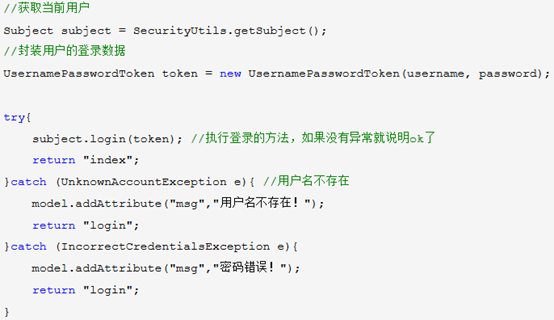
3.执行登录验证时会跳转到UserRealm类,首先执行认证(doGetAuthenticationInfo):连接数据库判断是否有此人,若没有则返回结果null,若有,则将数据库中的用户信息存储在subject的session中。接着进行密码验证,若验证失败,则将登录不通过返回失败认证信息,反之,返回成功的认证信息,并执行用户授权(doGetAuthorizationInfo)操作,返回授权信息。对应项目代码:
认证:
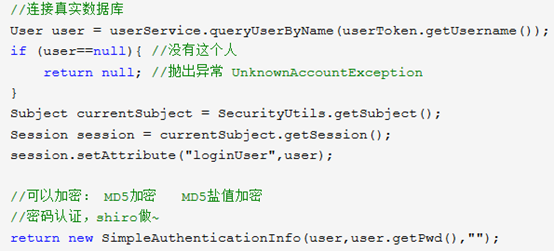
授权:
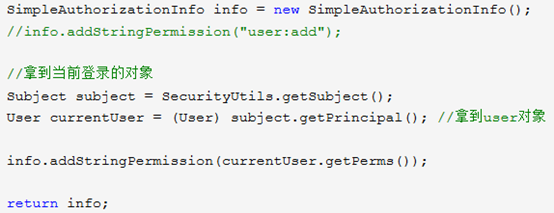
4.本项目中登录成功后跳转到index.html时依旧会再次执行授权操作,因为前端页面需要一个判断展示功能,代码如下:
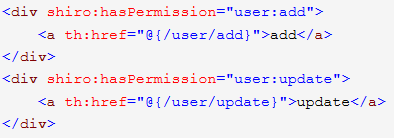
故控制台信息会是这样:(出现两次授权)
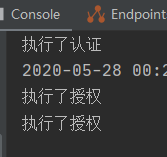
5.之后进入add.html或update.html时,因为会被拦截,所以都要进行授权验证,而此时认证将不会在执行。